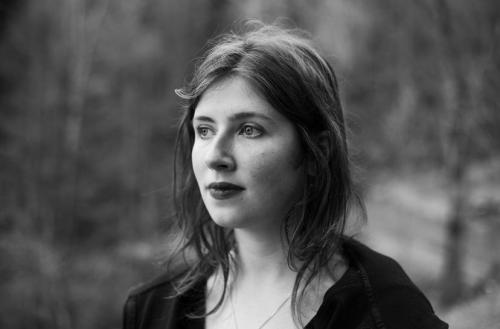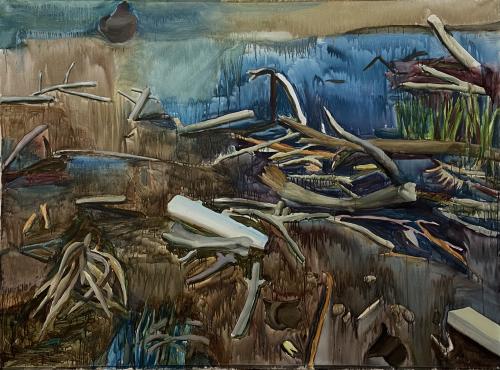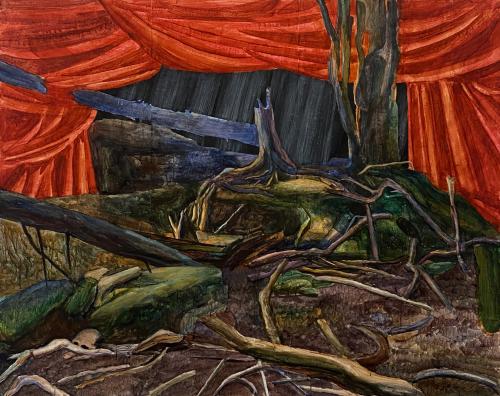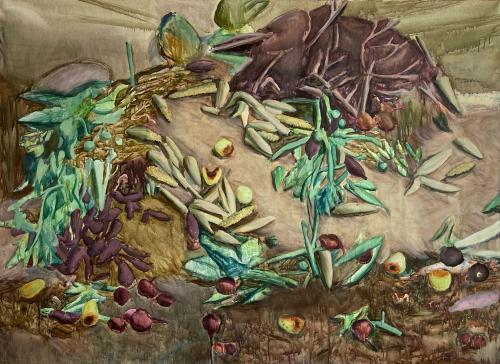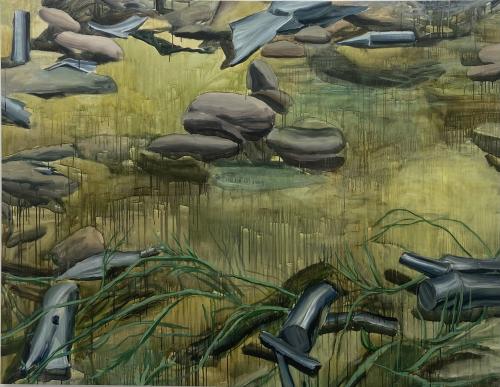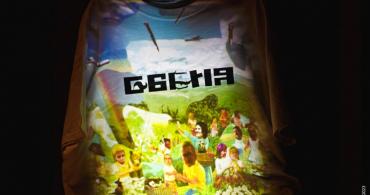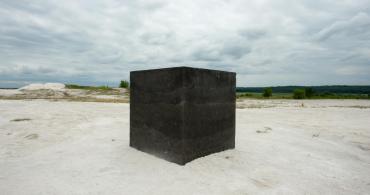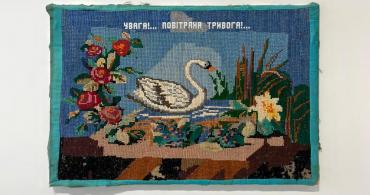Luhansk-born artist Katia Aliinyk tried many ways to get an art education: she read Henri Perruchot’s books about Toulouse-Lautrec, Cézanne, and Gauguin, bought at a flea market in Luhansk, studied drawing with the wife of a local priest in Rivne, where she lived in evacuation, and graduated from the National Academy of Fine Arts and Architecture cause she needed a room in a dormitory. She also listened to online lectures about contemporary art on YouTube. "After these lectures, I thought: "So there is really no future in lying in a snowdrift near the academy in a dirty jacket and painting bushes?" the artist comments on her turn to contemporary art. After that, she took courses at KAMA and the MethodFund.
In 2021, Aliinyk worked on the topic of the Luhansk region and created a series of medical and political fantasies about the region — paintings depicting the local soil in the section, revealing plant mutations underground. "It's a metaphor for the invisible bad processes that are happening in the east, on the other side of the border, processes that we can't witness, we can only imagine," Aliinyk explains. Since the full-scale invasion, the series has received a lot of attention from cultural professionals, and Aliynyk's work has been shown at exhibitions in Warsaw, Krakow, Berlin, Vienna, and Bucharest.
In addition to painting, Aliinyk works with fiction writing as an art form. In 2023, together with curator Natasha Chychasova, she released a zine titled “Collective Fantasies and Eastern Resources,” which touches on the topic of personal experience of displacement.
In a conversation with Lisa Korneichuk, the artist talks about the long journey home and Luhansk as a place that is always with her. With this publication, ArtsLooker continues a series of informative essays and interviews in partnership with the Museum Of Contemporary Art NGO and UMCA (Ukrainian Museum of Modern Art) about Ukrainian art during the full-scale war in the framework of the Wartime Art Archive preparation.
Without soil: artist Katia Aliynyk on her ongoing dialog with occupied Luhansk
***
Before Covid-19, my mom, sister, and I used to go to occupied Luhansk every summer. My grandparents and my father's family remain in the occupied territories. In the early years, there were a lot of checkpoints on the route, the road was torn up, it was hard, but then we somehow got used to it. To travel, we received an official pass from the state. Some people went through Russia, but we went through Stanytsia Luhanska. The train went to Rubizhne, and from Rubizhne, there was a bus that took a very, very long time to get to Stanytsia, that’s where the queues started. Usually, everyone with huge bags and belongings would stand in line at the Ukrainian border, then the same thing at the border of the 'Luhansk People's Republic,' and then from there, we would take a bus home. It took a little over a day, about 28 hours.
For many years, I thought that it hadn't affected me in any way. Only recently I realized that I was stuck in that time. It seems to me that when I went to Luhansk, I dissociated myself from my life — the city was frozen in time, it was not renovated in any way, nothing was built, and the asphalt was cracking. It was dusty, abandoned, and deserted. When I returned there in the summer, it seemed that I was 13 again and that life in Kyiv was a dream.

When we returned to Luhansk and were hiding in the basement among the pickle jars, I read “The Count of Montecristo” aloud to my grandfather, and he said: “Real adventures are always very uncomfortable.” We all did not believe until the end and did not want to understand what was happening. I realize it's terrible to call these events an “uncomfortable adventure,” but it was a defense mechanism, and it helped us survive that time a little bit.
Since 2014, I have had an inner fear that I will have to leave everything again. In Kyiv, I never settled down anywhere I lived and hardly ever bought things or books. I lived in a background mode of tension and expectation. So when the full-scale war started, I exhaled a little bit: "It's a good thing I didn't collect this library, it's a good thing I don't have anything." Of course, I wasn't happy, but I was relieved that this fear had found a logical conclusion. Since then, I no longer feel like my life is on hold.
During the war, I discovered the nomadic lifestyle, which turned out to be very comfortable for me despite the fact that I had been suffering all these years from being unable to go home like an average person. During the first months, my colleagues and I were surfing on a wave of adrenaline, so we worked pretty well. And I don't need much to paint: acrylic, canvas, brushes and some room. Since 2014, I had time to think about the occupation, so I started working very hard when I got the space and materials. Instead of panicking and bursting into despair, work saved me and gave me a sense of subjectivity.
I also felt I had much to tell because of my background and family. The image of Donbas is not always presented correctly, so my texts are aimed at destroying myths about Donbas. Because of this, I feel a little bit like I'm on duty. I hope that with my work, I am shaping and baking a brick that will form the wall of a strong facade for another Donbas image. Maybe I'm taking on too much (laughs).
I wrote the text “Who Else Eats Life with Spoons?” for the zine “Collective Fantasies and Eastern Resources” in Russian with a touch of dialects from Donbas. In the texts, I try to convey my fear that the physical destruction of places and people entails the destruction of intangible heritage — family history, regional history, dialects, knowledge of soil cultivation, and so on. Such things can be lost forever, and there is no way for me to go back to them to check them. That's why I chose this form of writing, where I tell stories in the language and tone I used to speak when in Luhansk, so it sounds familiar. People who read this text pointed out that it really sounds very “Donbas-like.” I really wanted to preserve this language quality, at least for myself, because I'm afraid that these memories will dissipate and I will lose them.
Research and development of materials, Wartime Art Archive website development, and media partnership with Suspilne.Kultura and Artslooker are implemented by the Museum of Contemporary Art NGO with the support of the Fritt Ord Foundation (Norway) and the Sigrid Rausing Trust (UK).
The text in Ukrainian is available on Suspilne.Kultura

